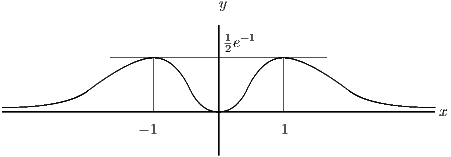Problem 50: More curve sketching ( ) 2001 Paper II
- (i)
- The curve
passes through the origin in the –
plane and its gradient is given by
Show that has a minimum point at the origin and a maximum point at . Find the coordinates of the other stationary point. Give a rough sketch of .
- (ii)
- The curve
passes through the origin and its gradient is given by
Show that has a minimum point at the origin and a maximum point at , where (You need not find .)
Comments
No work is required to find the coordinate of the stationary points, but you have to integrate the differential equation to find the coordinate. For the second part, you cannot integrate the equation — other than numerically, or in terms of rather obscure special functions that you almost certainly haven’t come across, such as the incomplete gamma function defined by
However, you can obtain an estimate, which is all that is required, by comparing the gradients of with and thinking of the graphs for . This is perhaps a bit tricky; an idea that you may well not alight on under examination conditions.
Solution to problem 50
has stationary points when , i.e. when , or . To find the coordinates of the stationary points, we integrate the differential equation, using integration by parts:
where we have used the fact that passes through the origin to evaluate the constant of integration. The coordinates of the stationary points are therefore , and .
One way of classifying the stationary points is to look at the second derivative:
which is positive when (indicating a minimum) and negative when and (indicating maxima).
Since as , the sketch is:

For , the stationary points are again at and . To classify the stationary points, we calculate the second derivative:
which is positive at (a minimum) and negative at (a maximum).
Since we cannot integrate this differential equation explicitly, we must compare with to see whether the value of at the maxima is indeed greater for than for .
For , , so and . Thus the gradient of is greater than the gradient of . Since both curves pass through the origin, we deduce that lies above for and therefore the maximum point on has .
Post-mortem
You were probably surprised that the examiners didn’t ask you to sketch ; they usually do. It looks as if it could be done, because you know that passes through the origin and you can relate its slope, roughly at least, to that of , which you did sketch. The difficulty lies in determining its behaviour as ; does as for ? In fact, it doesn’t; no reason why it should. Instead, . We shouldn’t have expected to asymptote to the -axis either; the fact that it does so is due to a rather delicate balancing of the two terms that determine its gradient.







